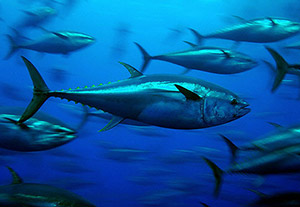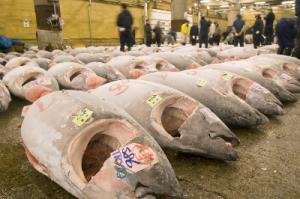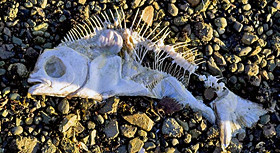(If you find this post informative, you might like to check out these.)
DAMN, where’s my bluefin tuna sashimi?!くそっ、私の黒鮪刺身はどこにありますか?!(Kusou, watashi no kuro maguro sashimi wa doko ni arimasu ka?!) |
From the Mediterranean to Japan, the bluefin tuna is being fished and eaten into extinction.
There are a few species of bluefin tuna, and all of them are in danger disappearing forever.
The species in the greatest danger of slipping into extinction is the western north Atlantic population (stock) of bluefin tuna. Thanks to 4 decades of overfishing, it has been driven to just 3% of its 1960 or pre-longlining abundance – a decline of 97%…
-“Atlantic Bluefin Tuna – Severity of Decline and its Causes“, bigmarinefish.com
Bluefin tuna sashimi is a delicacy the world over, wherever fanciers of Japanese live. This is a phenomenon ignited in the 1970s, and it may soon burn out, not because of waning demand but because demand is fueling the bluefin’s road to oblivion.
The hunting of highly valued animals into oblivion is a symptom of human foolishness that many consign to the unenlightened past, like the 19th century, when bird species were wiped out for feathered hats and bison were decimated for sport. But the slaughter of the giant bluefin tuna is happening now.
– The Bluefin Slaughter, New York Times
Before it got reduced to a raw morsel of gourmet ecstasy, the bluefin is a living fish, one of the largest fish apart from sharks (sharks are soft-boned or cartilaginous, while most other fishes including the tuna are bony fish). The tuna’s fishy biology is rare, for it’s a warm-blooded fast swimming fish, the Lamborghini of the seas. Like those gas-guzzling monsters, bluefins are fantastical swimmers capable of hitting 70kmh, traversing the oceans from north to south, east to west, several times a year. They are highly evolved fish, advanced in design, with amazing navigation systems, able to locate prey with their sonar, but closing in with their large eyes. They can even dive down to almost 1000m deep. And like the supercars, these superfish have voracious appetites, requiring 25 kilos of prey to gain 1 kilo of weight. Their average lifespan is 15 – 30 years, and it takes them up to 12 years to go from puny microscopic larvae carried along by currents to sexually mature, sleek giants averaging 2m in length.
It seems like apart from growing up quickly, there’s nothing this beautiful fish can’t do, but it cannot escape extinction if people insist on eating them off the face of the earth.
Stop the gluttony: save the bluefin tuna from extinction!大食家の貪欲を止めてください:黒鮪を絶滅から救ってください!(taishyokuka no donyoku wo yamete kudasai: kuro maguro wo zemmei kara sukutte kudasai!) |
Tuna looks like this to most people – the beginning of sushi, the ignomy of a frozen piece of multilated meat. But it is the end of life, or a parodic prophesy of the bluefin’s future, driven by human greed and gluttony
As Prince Albert, Monaco’s ruler, wrote in the Wall Street Journal:
The forces of selfishness and stupidity that wiped out the great whales and the northern cod in the last century are steaming ahead at full speed… The bluefin tuna is as endangered as the giant panda and the white rhino.” Unless a ban is enforced almost immediately, the only examples of the species could be found in large aquariums.
Is it too pessimistic a view? It doesn’t seem to be, given this typical of the editorials on the state of things:
… what was once known as the common tunny has, over the past few decades, come to be at serious risk of extinction, thanks to overfishing driven by demand from Japan, where bluefin tuna are considered a delicacy and are used in sushi and sashimi.
Efforts to protect the species have floundered.
– So long, and thanks for all the fish, Economist.com
How did it come to this?
From Horse Mackerel to Sushi
The bluefin was not always considered a delicacy. In the early 1900s the fish was known
as “horse mackerel,” and its red, strong-flavored flesh was considered suitable fare only for dogs and cats. Nevertheless, big-game fishers off New Jersey and Nova Scotia targeted the bluefin because these powerful fish were considered worthy opponents… Although swordfish were certainly considered edible, tuna and marlin were thought of as strictly objects of the hunt. The bluefin did not become valuable as a food fish until the latter half of the 20th century, when sushi began to appear on menus around the globe.
– The Bluefin Tuna in Peril, Scientific American
Yes, sport fishing is a culprit along with sushi gobblers, but the bulk of culpability lies with the sushi and sashimi lovers.
Supplying tonnes of tuna means mass fishing techniques, which are indiscriminatory about what gets snared. Non-target species like birds, turtles, sharks, whales, dolphins, seals, and other fish species become by-catch, sacrificed needlessly.
… long-line fleets are fishing blind, with little or no understanding of their devastating impact on threatened species,’ says Dr Simon Cripps, Director of WWF’s Global Marine Programme. ‘Responsible countries must urgently implement measures to dramatically reduce the death toll.’ The new report exposes ten years of inaction by members of the Commission for the Conservation of Southern Bluefin Tuna (CCSBT), and calls for reform measures to be agreed at their annual meeting in Australia next week to stem the catch of endangered wildlife and reduce chronic overfishing.
– Southern Bluefin Tuna fleets endanger a wide variety of wildlife, warns WWF
Take positive action before it’s too late for regrets
悔悟のために遅すぎである前に、確かな行動をとってください(Kaigo no tame ni susugi de aru maini, tashika na koudou wo totte kudasai> |
Can you imagine a day where the bluefin tuna has come to the end of the line? A day where there’s no fish? Bluefins are to fishes what whales are to cetaceans.
But for the diehard fan of maguro, especially otoro, the question burning the tastebuds and churning the gastric juices in the guts must be : Is this the end of sushi?
Sushi connoisseurs tend to be obsessive folks – I know because I am one. If we think we must sacrifice good sushi to save the bluefin, we may just as well keep eating bluefin.
– Better sushi, but without bluefin tuna, The Christian Science Monitor
Old habits die hard, but what about older habits that were buried by the old habits?
The people who come to my dinners are American sushi eaters ready to experience and understand a completely authentic Japanese meal….
And guess what? There’s no bluefin on the plate. There’s no toro, no hamachi, no unagi, and no fatty salmon. None of these usual suspects of today’s global sushi business are part of the traditional sushi lineage. In fact, until just a few decades ago the Japanese considered tuna a garbage fish.
It wasn’t until after World War II, when the Japanese started eating a more Westernized diet, with red meat and fattier cuts of it, that the bluefin fad began. And it was a fad practically invented by Japanese airlines, so they could load their international flights with pricey cargo.
– Better sushi, but without bluefin tuna, The Christian Science Monitor
How do you kick an old habit, one that is harmful? By looking further back to when things were better, more sustainable.
A Japanese chef named Hajime Sato did what celebrity chef Matsuhisa has not had the wisdom to do. With the help of a seafood conservation expert named Casson Trenor, Chef Sato converted his sushi bar, Mashiko, to an entirely sustainable menu….
Sato no longer serves bluefin. And he’s thrilled. “I found probably 20 more fish that no one uses for sushi anymore,” he says. “My restaurant has so much more different fish that I can’t fit them all into the new menu.”
Sushi doesn’t need to die because the bluefin is endangered. With our help, sushi can be reborn – better than ever.
– Better sushi, but without bluefin tuna, The Christian Science Monitor
Some may point to farming as a way out. But no, it is really another farcical false hope.
It may not be too late to do the right thing and keep the legacy meant for our future generations intact, a LIVING planet filled with the amazing bluefin and its fellow dwellers of the deep.
Yet even if the trade in bluefin tuna were to be halted completely, there would be no guarantee that the species would recover. Experience with other fisheries, such as the collapse of the cod population of the Grand Banks off Newfoundland in 1992, has shown that the dynamics of an ecosystem can change when a top predator is removed completely. Fifteen years later, the northern cod stock has not recovered.
– So long, and thanks for all the fish, Economist.com
(Incidentally, the intensification of the annual Canadian seal slaughter used the cod fisheries’ collapse as its excuse. Ref “Scientific Study – my fish!“)
Efforts to study and understand the bluefin tuna are underway. In fact, 1 scientist has said:
“To say there’s not enough science to tell us whether we need to protect the last few fish that are trying to breed on our side of the ocean, that is just nonsensical,” he said. “I believe that is illegal. The law requires better stewardship than [government officials] sitting on their hands and doing nothing.”
– Advocates Hope Science Can Save a Big Tuna, Washington Post
But we must bear in mind that even if the bluefin is saved, it still does mean we can feed the bluefin to our feckless appetites again anytime soon:
At the moment bluefin tuna has no protection under Cites, the only global body with the power to limit or ban international trade in endangered species.
If bluefin tuna are given protected status at the meeting in Qatar next March the sale of the fish on international markets would be banned although it could still be sold locally.
Such a measure would eliminate the main cause of over-fishing: the strong demand for the delicacy as sushi and sashimi in countries such as Japan and the United States.
– EU considering bluefin tuna protection
It’s not just Japan (but even Japanese think tank are urging Japanese to spare the bluefin). Bluefin tuna are missing from Danish waters since the 1960s, the annual mattanza in Sicily. In fact, it’s not just tuna that’s got problems.
No nation can claim innocence. No one. Even in tiny lawful Singapore, illegal food encounters are not unheard of.
Though there seems to be hope, this constant yo-yoing between austerity and glut cannot be good. Can we actually learn? The insidious food, inc has its claws in every aspect of the human food chain, whether on land or in the seas, and consumers are not guiltless in the concocting of this recipe for disaster. The important thing is for consumers, you and me, to realise what we’re doing (or not) with our habits, and do the right thing.
ADDITIONAL INFORMATION
Mercury Poisoning: People who eat a lot of fish may run health risk. (Latest “HOT” victim – Jeremy Piven)
Problems for Sharks and Dolphins:
All the Tuna you buy comes from wild fish, some caught using vast purse-seine nets to scoop them out of the sea, and some from lines of baited hooks many miles long. Unfortunately these methods catch many other creatures at the same time, including sharks. Longlines around New Zealand are said to have caught 450,000 blue sharks in 10 years!
And there are serious problems for Dolphins. Follow these two links to start researching them. Dolphins may be caught at the same time, or Dolphin mothers may be separated from their young.
Weekend Movie Choice: The Cove
[NOTE: Any comments in Japanese will not have any response from me. The Japanese title and section headings are to pique interest only. While I have studied Japanese, it was a long time ago – but with thanks to the internet, it was a easy task to get translations.]
(If you find this post informative, you might like to check out these.)






 Looking for caregivers in these areas
Looking for caregivers in these areas

















 China's Shocking DOG and CAT fur trade.
China's Shocking DOG and CAT fur trade. Circuses.com: Please say "No", because animals can't.
Circuses.com: Please say "No", because animals can't.






























Pingback: Weekend Movie Choice: The Cove « Tipped Ear Clan
Pingback: There be giants… and Man likes’em better dead « Tipped Ear Clan